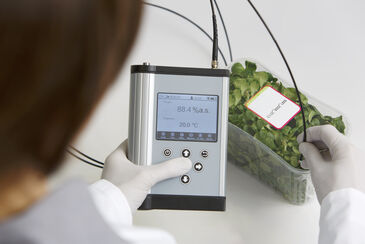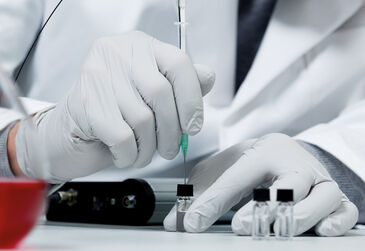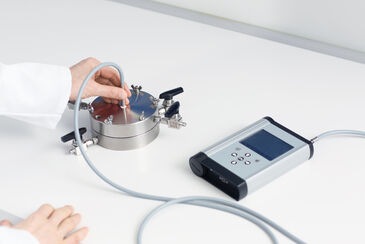Watch tutorials, webinars and informative videos about PreSens optical sensor systems.
Oxygen Measurement in Packaging

The tolerable amount of oxygen inside packaging can vary greatly depending on the product. Many goods are sensitive to oxygen, like certain foods, pharmaceuticals or technical applications and must be protected by the appropriate packaging material. It is very important to determine the barrier properties of packaging and other synthetic materials as well as the amount of oxygen in the final filled packaging to guarantee the safety of the product and prolong its shelf life.
Undesired oxygen in packaging, can lead to oxidative deterioration of foods, and shorten the shelf-life of certain products. However, with fresh and respiring goods a high oxygen permeability of the packaging material is required. The tolerable oxygen uptake may range from below 1 µg package-1 day-1 in case of beer [1] up to 1 g package-1 day-1 for highly respiring fruits and vegetables [2].
Oxygen can be taken up during the filling process, enter the packaging through untight lids or permeate through the packaging material itself over time. Therefore, routine oxygen measurements in packing and filling facilities are essential for quality control.
The right packaging materials are just as important as frequent quality checks. Material research is a rapidly growing science field since we must address our planet's plastic waste problem. New materials that might be more easily degradable still have to fulfill the requirements of product safety and protect oxygen sensitive goods.
Appropriate and reliable oxygen measurement methods that are easy to apply are essential for quality control and material research.
References:
[1] Kuchel, L.; Brody, A. L. and Wicher, L.: Oxygen and its reactions in beer, Packaging Technology and Science 19 (2006), No. 1, pp. 25 – 32
[2] Müller, K., Gibis, D.: PACKAGING DESIGN FOR CHILLED PRODUCT. In: Kreyenschmidt, J. (ed.): Proceedings of the 4th International Workshop Cold Chain-Management, Bonn, Germany, Sept. 27-28, 2010, ISBN-978-3-9812345-1-0
The great variety of packaging made from different materials puts different demands on the sensors used for quality checks or OTR (oxygen transmission rate) measurements.
Traditional Clark-type oxygen sensors are often too large for this type of application. An opening must be made in the packaging wall, or a special lid must be used, that allows to insert the sensor, and great effort must be made to keep atmospheric oxygen from entering the packaging and falsify the measurements. Furthermore, these sensors consume oxygen in the measurement process.
Using optical oxygen sensors these disadvantages can be overcome. These sensors come in a variety of different designs and can be applied in quality assessments during production and filling processes, or for testing the leak tightness of packaging or material properties. With optical measurement systems oxygen ingress in packaging can be determined under realistic conditions. (e. g. in carbonized liquids, under pressure).
Non-invasive O2 Measurements in Transparent Product Containers and Bottles
Optical O2 sensor spots are the right choice for measuring oxygen inside transparent or slightly colored containers. These very small sensors (Ø 5 mm) are available in a version approved for the use with food products and allow contact free oxygen read-out. The sensor spots are attached to the inside wall, below filling level or in the headspace area of the container. After filling and closing the container the oxygen content inside the product and the headspace can easily be determined by holding a polymer optical fiber connected to the oxygen meter against the outside wall opposite the sensor spot. This technique has already been applied to investigate the oxygen content in glass beverage bottles with different closures - crown caps and swing stoppers. However, oxygen is not only dissolved in the product, or taken up while filling, but it also migrates out of – or permeates through – the packaging material into the product. Oxygen sensor spots have also been used to investigate the oxygen barrier properties of differently treated PET bottles. You can read more details about these experiments on our Oxygen Ingress in PET Bottles page.
Microinvasive O2 Measurements in Non-Transparent or Pharmaceutical Packaging
For non-transparent containers and for measurements in smallest volumes needle-type oxygen microsensors can be used. These sensors are housed in a syringe needle that allows to pierce the packaging material and determine the oxygen content in gas and liquid inside the container. A septum is attached to the packaging to avoid oxygen entering the container when piercing through its wall. Optical O2 microsensors have a fast response time and stable measurement values can be obtained within seconds. Their sensor tips have diameters down to 50 µm, so they allow measuring oxygen in smallest volumes, like e.g. in blister packaging or the headspace of pharmaceutical vials. As the microsensors do not consume oxygen during the measurement process precise results can be obtained even in volumes of a few mL.
Determining Barrier Properties of Synthetic Materials
Optical oxygen sensors are available for measurements in normal oxygen range (detection limit 15 ppb dissolved oxygen, 0 - 100 % O2), trace range (detection limit 1 ppb dissolved oxygen, 0 - 4.2 % O2), and even ultra-trace range (detection limit 0.5 ppmv O2, 0 - 200 ppmv O2 in gases). This makes these sensors the ideal tool to determine the barrier properties of synthetic materials. PreSens has developed a special leak tight chamber in which high or low barrier synthetic films can be tested. Fixed between two chambers, which can be individually filled with gas or liquid, the oxygen transmission rate of the material can be measured under real conditions (e.g. under pressure).
Non-invasive O2 Measurements in Transparent Packaging
O2 sensor spots integrated in transparent or slightly colored containers can be read out with one of our portable, handheld oxygen meters or with small benchtop devices that are PC-controlled. Both set-ups are ideally suited for fast checks and successive measurements in multiple containers, or long-term measurements to assess oxygen ingress. The oxygen measurements are displayed in real time on screen.

- Fibox 4 (trace) + Polymer Optical Fiber + O2 Sensor Spots
Read more

- OXY-1 SMA (trace) + Polymer Optical Fiber + O2 Sensor Spots + PreSens Measurement Studio 2
Read more
O2 Measurement in Small Headspace
The solution for measurement inside blister packaging is an oxygen microsensor with fixed sensor tip. The optical fiber coated with the oxygen sensitive material is fixed inside a robust syringe needle that can be pierced through the septum and blister material. Unlike with other microsensors, the sensor tip does not have to be extended and therefore the sensitive fiber cannot break when placed in the small space between product and blister wall. The O2 microsensor with fixed sensor tip can be connected to a portable oxygen meter with display, or a small benchtop device that is controlled from a PC with the intuitive PreSens Measurement Studio 2 software.

- Microx 4 (trace) + NFSG
Read more

- OXY-1 ST (trace) + NFSG + PreSens Measurement Studio 2
Read more
Microinvasive Oxygen Measurement in Tetrapack or Vials
Oxygen microsensors are ideally suited for measurements in non-transparent packaging like e.g. Tetrapack or in pharmaceutical vials. The optical fiber coated with the oxygen-sensitive dye is housed inside a syringe needle, that can be pierced through the septum and the packaging material. When the microsensor is in place the tiny sensor tip can be extended (pushed out of the syringe needle) for measurement. The microsensor can be connected to a portable oxygen meter with display or a small PC-controlled benchtop device. By inserting the microsensor deeper into the packaging oxygen measurements not only in the headspace but also in the product can be conducted – all in one go!

- Microx 4 (trace) + NTH
Read more

- OXY-1 ST (trace) + NTH + PreSens Measurement Studio 2
Read more
Oxygen Transmission Rate Determination of Synthetic Materials
PreSens has developed a special solution for oxygen transmission rate measurements in synthetic films. This device is already applied in material research. The permeation cell is a leak tight two-chamber system. Each chamber can individually be filled with liquid or gas, so measurements under real conditions can be performed. The synthetic film is fixed between the two chambers. In the upper chamber an oxygen sensor spot is integrated – according to the expected barrier properties of the material under investigation either a normal range, trace range or ultra-trace sensor. Then the upper chamber is filled with oxygen free gas or liquid. Now long-term measurements can be conducted with a portable oxygen meter to see how much oxygen gets through the synthetic material over time.

- Fibox 4 (trace) + Polymer Optical Fiber + O2 Sensor Spots + Permeation Cell
Read more





